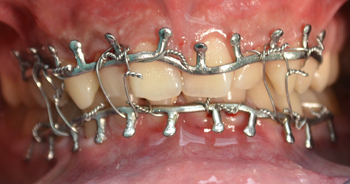5 New Methods for Losing Weight You Won't Believe Are Legal

The media will never tire of telling us that America is the fattest nation on Earth, and how the sheer mind-boggling mass of its gargantuan ass is dragging all the other Western nations into a deadly orbit around obesity. There are thousands of weight loss solutions available, and they range from "technological snake oil apps" to "not eating quite so damn much." And then there are these, which all sound like bizarre torture methods you'd find in a sci-fi flick.
Getting a Brain Implant

Deep brain stimulation therapy is a new technique that uses electrodes planted directly in your brain to silence your hunger pangs without you having to hork an intact sleeve of Chips Ahoy! down your throat-hole like a duck.

"The trick is to soak it in stagnant pond water first."
The process is as simple as it is terrifying: First, doctors clamp your head in a vice, then they drill some holes in your skull, and then they gently place some electrodes into that sweet spot of your brain that regulates metabolism. And how do they know they're hitting the right place? The target is conveniently situated next to your body's internal thermostat, so they know they've got it when you tell them that you're starting to feel really warm. Oh, did we mention you're awake during all of this?

"While you're in there, can you erase the time I caught my grandparents having a nooner?"
After these little cattle prods are firmly embedded in your gray matter, you spend a week in a special metabolic chamber while doctors fiddle around with the system, stimulating your metabolism by tweaking your brain's settings like it's a video game. The end result is that you feel satisfied after eating much less than you ordinarily would, because your brain is now a rat in a Skinner box that gets zapped when it gets too greedy.
Three human subjects have already undergone this procedure, and all have lost a considerable amount of weight. More experimentation is required to determine how much of the effect is attributable to the electrode stimulation and how much is due to the robots hollowing out your body and replacing your organs with carbon fiber.
Stopping Food via Dentistry

Unless you have been wildly misinformed about how eating works, most food enters your body by way of your mouth. Research shows that people who take longer to eat wind up consuming smaller meals, so if discipline fails you, then the next best solution is to shrink your face-hole. For instance, there's a $500 device called the DDS system. Similar to a retainer, it fills up most of your mouth cavity so that you can't open your maw and hoover everything around you into it like a Sarlacc.

It's a two-pronged approach, as the $500 price tag also takes a pretty big bite out of your milkshake budget.
If retainers bring up too many painful memories of acne and cancelled prom dates, you could try the Slow Bite instead -- a flexible device that looks like the cross section of a facehugger. The device is inserted between the teeth before every meal, limiting how much you can open your mouth and forcing you to take smaller bites.

Also giving everything you eat the delicious tang of disposable latex.
For those who lack the willpower required to insert something like this before each meal, there's a more permanent option: orthodontic jaw wiring. Basically, it's a set of braces that looks like it was installed by Steve Martin's character from Little Shop of Horrors.

Part lockjaw patient, part Flavor Flav.
The braces wire your jaws so that you can't open your mouth more than a quarter of an inch, preventing you from eating anything but pureed goop for the duration of the experience, which lasts somewhere between the time it takes to lose weight and the time it takes to start showing signs of insanity. No, seriously -- one condition of orthodontic jaw wiring is that you carry a pair of wire cutters with you at all times, because apparently it can lead to panic attacks and nausea, and vomiting with your mouth wired shut is a recipe for disaster. Fatal disaster.
Beyond impairing your ability to breathe, talk, and perform oral sex (unless your partner drives a Hummer), you'll also have to worry about bad breath, chapped lips, and sneezing (because it might damage the wiring). On the plus side, orthodontic jaw wiring patients have attested that it is no worse than a tooth extraction, a comparison that assures us that 100 percent of them are insane masochists.
The Nose Tube Diet

Going off solids completely is a good start, but your cholesterol-deprived brain might still drive you to blend a pack of Oreos into a buttershake. For those folks, there's the K-E diet, a regimen in which the patient is fed exclusively via a nasogastric tube, which is an awfully fancy term for a pipe to your stomach that goes in through one of your nostrils.

And hopefully ends in a bottle of Wild Turkey so you can blot the whole thing out.
Participants are fed a low-carb diet through their nose for 10 days, shedding pounds via a process known to scientists as "ketosis," and to the rest of us as "starvation." Depriving the body of carbohydrates makes it eat away at its fat stores quickly, so it's actually pretty effective for short-term weight loss. So, you ask, if it's all diet-based, why not just avoid bread and skip the nose tube? Because the inventors feel you need to be punished for being fat in the first place, obviously. How are you going to learn not to do that if they don't waterboard you with chicken puree for most of a fortnight?

There's no way your "dietician" resisted the urge to pee in this.
Wow! A crash diet that both makes you look and is insane? What's the catch? Beyond the price tag of $1,500 for what is essentially the Atkins diet liquefied and pumped through your nasal cavity, there are also some side effects. Constipation, dizziness, and bad breath are what you'd share with anyone who all but stops eating, but the tube brings its own unique twist, with risks of lung infection and the erosion of tissue in the nose and throat. But everybody knows that hacking up blood is hot. Look at Val Kilmer in Tombstone!
Assaulting Your Stomach

One way to combat the tyranny of the stomach is to shove a balloon or two down your throat so that it tricks your body into believing it's always full. That's why heroin smugglers are so incredibly sexy. If you desire that fashionable drug mule look, invest in the ReShape Duo: two bubbles inflated with water that sit in your stomach for six months, drastically reducing the number of doughnuts you can shove down there before your body cries out in anguish.

To save space, you may want to drink the Bavarian cream by itself.
And there are other ways to thwart your all-consuming voraciousness. For example, one reason you get hungry again only a few hours after your last meal is that the stomach has already dumped that food down into your intestinal tract and sent it off on a magical journey that ends, as they all do, in poop. That's why you need a stomach plug like the TransPyloric Shuttle, which acts like a bouncer at the entrance to your intestines, reducing the torrent of food ceaselessly cascading toward your butthole, thus keeping you sated for longer.

Congrats. Your stomach is now a toilet tank.
And if all else fails, there's always the AspireAssist Aspiration Therapy System. This is a surgical procedure invented by the visionaries who gave us the Segway, which probably explains why it's so objectively terrible. The AAATS is a tube directly between your stomach and a "skin port" that has been installed in your abdomen like a Cronenbergian nightmare. After eating a nice, normal meal with friends, you simply excuse yourself to the bathroom, attach a tube to the skin port, and empty the contents of your stomach into the toilet. Then burn any residual calories by violently weeping at what humanity has become.
Big Brother for Your Eating Habits

If all of the previous blitzkriegs against your body fail, you can always opt for the Tantalus II System from Vanderbilt Medical Center, which electrocutes your rebellious gut into submission. The Tantalus is like a pacemaker for the stomach, except instead of preventing heart attacks, it provides "programmed electrical stimulation" via an "Implantable Pulse Generator (IPG)" that senses "Gastric Contractility Modulation (GCM)." Here's a tip: If it reads like somebody spent 20 hours lost in a thesaurus trying to avoid telling you what something does, what it does is probably a bit disturbing.

"Don'tsaybellytaserDon'tsaybellytaserDon'tsaybell-"
There are different types of these devices, but for the most part, they work the same way. Each includes a sensor to tell it when your stomach revs up, meaning a meal has started. It then short-circuits the process by sending the "OK, done here" signal to your brain. Meals can only be consumed within a predetermined window of time -- if a patient ventures out to snack, the device detects the infringement and, we don't know, sends out the Dorito Enforcers to throw you in the Celery Gulag or something. But it doesn't end there. Some of the devices have the ability to actually record and upload your meal data so that your physician can view it and know exactly how disappointed to be with you at your next appointment. One device, Abiliti, even allows you to join a social network with all of your self-hating cyborg friends, who can virtually chastise you whenever you break ranks and give in to the cheap desires of the meatspace.

"The Meatspace" of course being that burger place downtown that keeps nacho cheese in the soda fountain.
You can now sync your bowels with social media. There is no such thing as satire anymore; there is only terrible prophecy.
Special thanks to Sivan Tzidon for her assistance in researching this article.
Related Reading: For a look at the insane realities behind those crazy infomercial ads you see on late-night TV, click here. If you prefer your weight-loss tips delivered by cynical bastards, Cracked can also help. Rather have the very worst diet fads in history at your fingertips? We can help.
